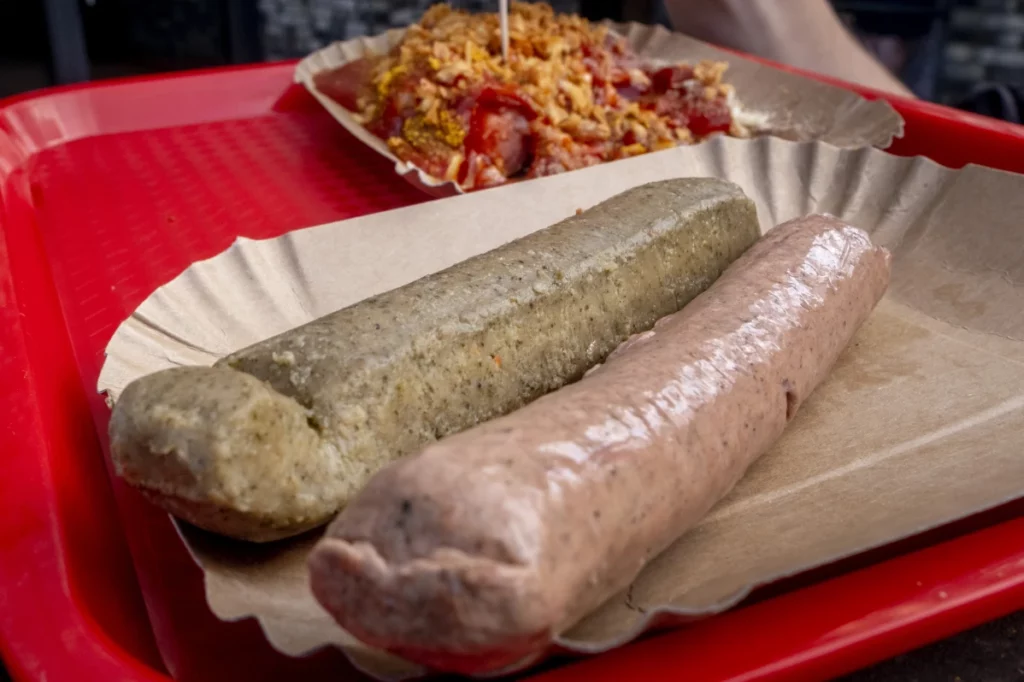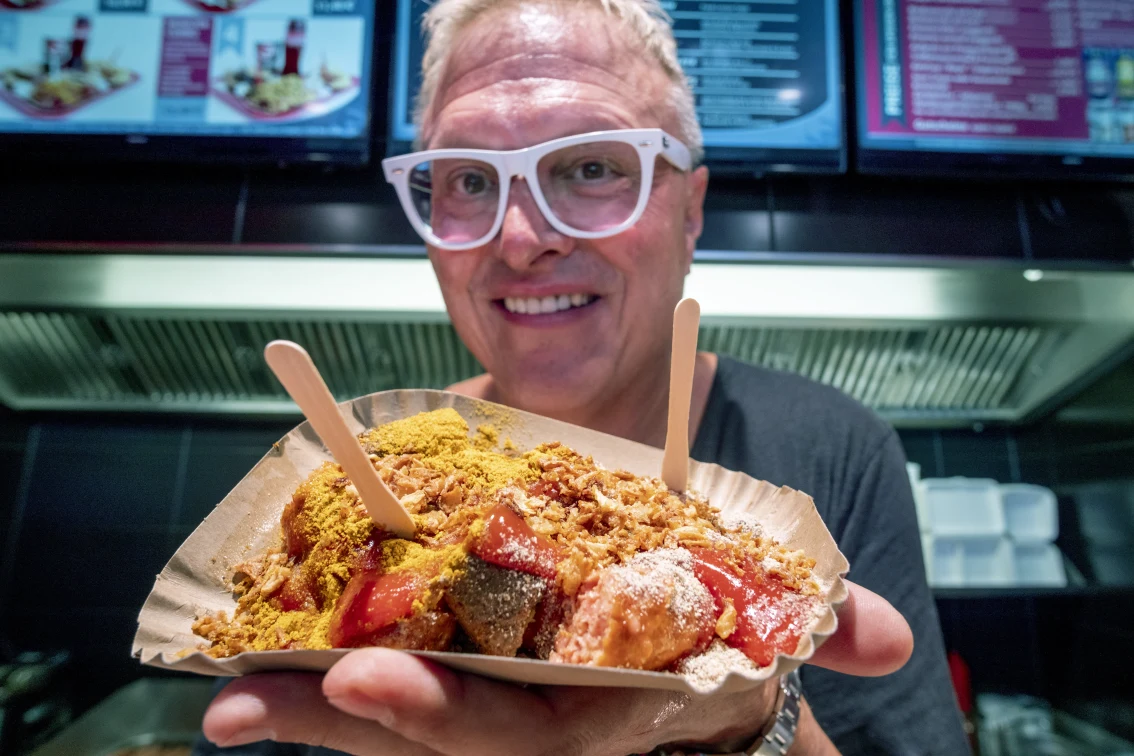When Lars Obendorfer first started selling vegan sausage at his 25 German stands, dubbed “Best Worscht in Town,” he says he was “badly insulted.” He even found himself settling disputes among customers over social media.
He stated, “There was downright hostility between the vegans and the meat eaters.”
This occurred six years ago. Today, 15% of the 200,000 frankfurters every year are plant-based.
Yasemin Dural, a customer, stated, “It actually tastes like a normal sausage.”

Two kinds of veggie lover wieners are shown at a “Best Worscht around” branch in Frankfurt, Germany, Friday, June 16, 2023. ( AP Photograph/Michael Probst)

A veggie lover curry wurst is displayed after profound searing at a “Best Worscht around” hotdog stand in Frankfurt, Germany, Wednesday, Sept. 13, 2023. ( AP Photograph/Michael Probst)
Eating more plants and less creatures is among the least difficult, least expensive and most promptly accessible ways for individuals to decrease their effect on the climate, environment researchers have long said. One study from the University of Michigan found that if half of the foodstuffs consumed in the United States that are based on animals were substituted with foods made from plants by 2030, the emissions reduction for that year would be the same as taking 47.5 million cars off the road.
A blast of new sorts of plant-based “meat” — the burgers, chunks and different cuts that intently look like meat yet are produced using soybeans and different plants — is drawing in clients from one side of the planet to the other. According to Euromonitor, a market research company, global retail sales of plant-based meat and seafood more than doubled to $6 billion between 2018 and 2022.
But that pales in comparison to the global retail sales of packaged animal meat and seafood, which increased by 29% to $302 billion during the same time period.
Additionally, sales have fluctuated. Plant-based meat sales have stagnated in the United States, despite rapid growth in demand in Germany and Australia and other nations.
WHAT NEXT FOR THE RESCUE?
Meat made from plants has been around for a long time. In 1975, breakfast sausage made from soy was introduced by Morningstar Farms, a division of Kellogg Co. However, about a decade ago, companies like Impossible Foods and Beyond Meat began selling burgers that were intended for carnivores and more closely resembled meat.
Those items immediately grabbed hold in Germany, where boundless worry about environment and creature government assistance have been driving enormous changes. The amount of meat consumed annually by Germans dropped to 52 kilograms (114 pounds), the lowest level in 33 years. According to Euromonitor, plant-based meat sales increased by 22% at the same time.
Retail sales of plant-based meat have increased by 32% between 2020 and 2022 in Australia, where the average person consumed 264 pounds (120 kilograms) of animal meat in 2020, according to the United Nations.
Health concerns are altering Australians’ habits, according to Sam Lawrence, vice president of policy for the Asia division of the plant-based advocacy group Good Food Institute.
However, it is the U.S. that addresses one of the greatest expectations for an answer: It is the biggest market for alternatives to meat. According to the United Nations, it is the second-largest consumer of meat per capita after Hong Kong, making it one of the largest contributors to animal agriculture’s greenhouse gas emissions.
Tyler Huggins is aware that reversing that trend would significantly alter global meat consumption.
Huggins is the prime supporter and Chief of the plant-based food organization Meati. He comes from a group of buffalo farmers he actually eats meat at times. However, he says it’s basic to wean Americans from their meat-weighty eating regimen on the grounds that the nation is as of now utilizing the vast majority of its arable land.
Meati, based in Colorado, uses mushroom roots to make chicken cutlets and steak filets that are chewy and fibrous. Its chicken cutlet has nearly the same amount of protein and less calories than animal chicken. It also has less cholesterol.
Meati ferments spores in stainless steel tanks filled with water after feeding them sugar from mushroom roots. A single microscopic spore can produce enough meat to fill a whole cow in four days.
A Taste Matter
Meati went onto the plant-based meat scene in 2017, around the very time that many others were attempting their hand in the space. US. Between 2017 and 2020, sales of plant-based meat increased by more than double to $1.6 billion. However at that point deals leveled, creeping up only 2% somewhere in the range of 2020 and 2022.
Some argue that the high cost of meat substitutes restricts their appeal. Yet, Peter McGuinness, the Chief of spearheading plant-based burger creator Unthinkable Food sources, says taste is the greatest issue.
“I think the classification isn’t sufficient,” McGuinness said. ” What is the main thing individuals need in food? Taste. In the event that I don’t have the taste, they couldn’t care less about the cholesterol and the soaked fat.”
According to a recent survey conducted by The Associated Press-NORC Center for Public Affairs Research, approximately 8 in 10 adults in the United States consider taste to be extremely or very important when purchasing food, followed closely by cost and nutritional value. Only 34% of Americans place a high priority on the food’s impact on the environment or animal welfare (30%).
The Planet’s Best Interest
The plant-based competitor has sown its own doubts in the meat industry. The Center for Consumer Freedom has criticized plant-based meat in Super Bowl and newspaper ads, claiming that it contains “chemicals and ultra-processed ingredients,” though it won’t say which food companies fund it.
Plant-based food sources have a few advantages over meat; they have no cholesterol, for instance, and may have not so much fat but rather more fiber. In any case, plant-based food varieties can likewise be higher in sodium.
Past Meat, one more trailblazer on the lookout, is centered around working on the wellbeing of its items. However, Past Meat’s pioneer and Chief Ethan Earthy colored expresses that in places like Germany — dissimilar to in the U.S. — worries about wellbeing are offset by worries about the climate.
Adrienne Stevson does not have that problem. Stevson, a graphic designer from Johnson, Vermont, spent most of her life eating a lot of meat. She was therefore skeptical when her partner switched to veganism. She became more open to plant-based meat, however, the more she learned about the climate benefits.
“I figure in an ideal world we could live with eating dairy items and meat items,” Stevson says. ” Yet, there’s an excessive number of individuals on the earth and we haven’t tackled the issue of creature farming for that many individuals in a practical manner.”

